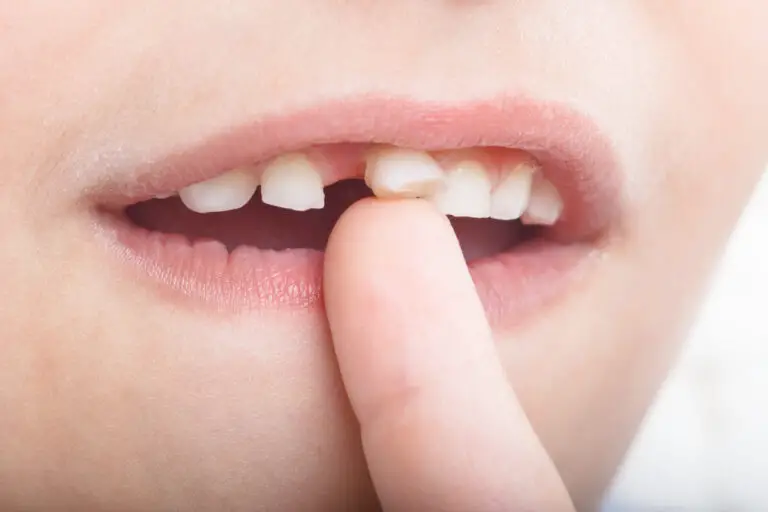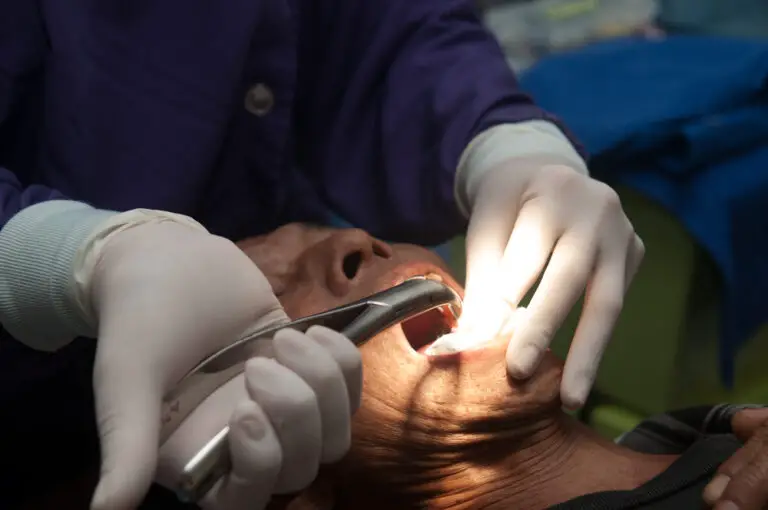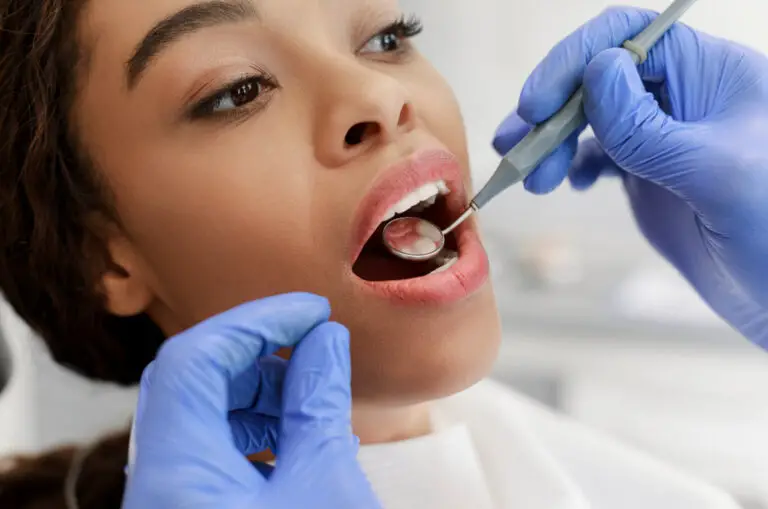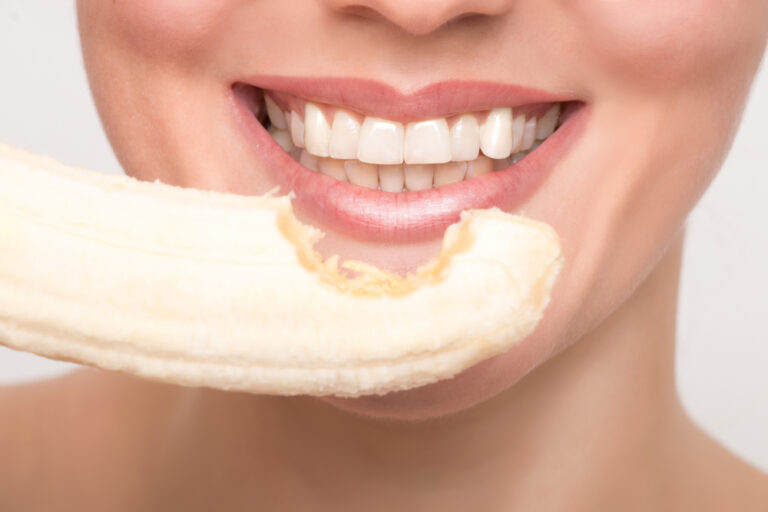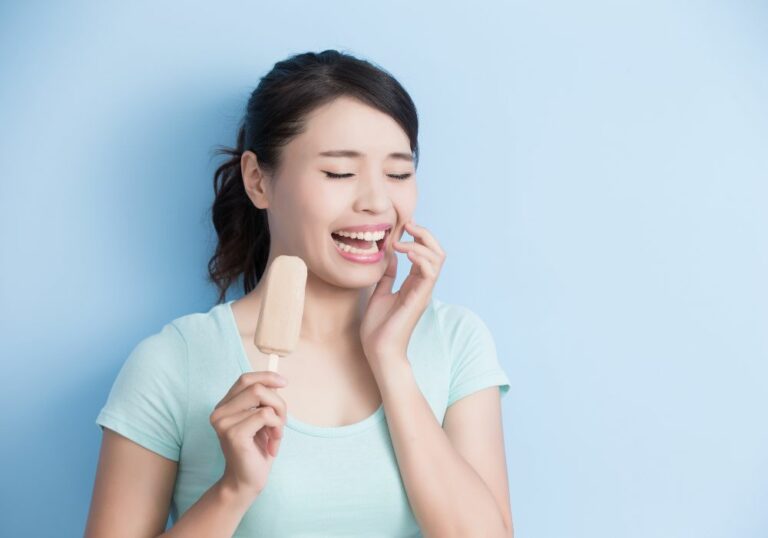Braces are a common orthodontic treatment used to correct misaligned teeth and improve someone’s bite. While braces are effective at straightening teeth, a common side effect is teeth discoloration. Teeth can turn yellow or even brown while wearing braces. This article will examine why this occurs and what can be done to prevent or treat discolored teeth from braces.
Reasons for tooth discoloration with braces
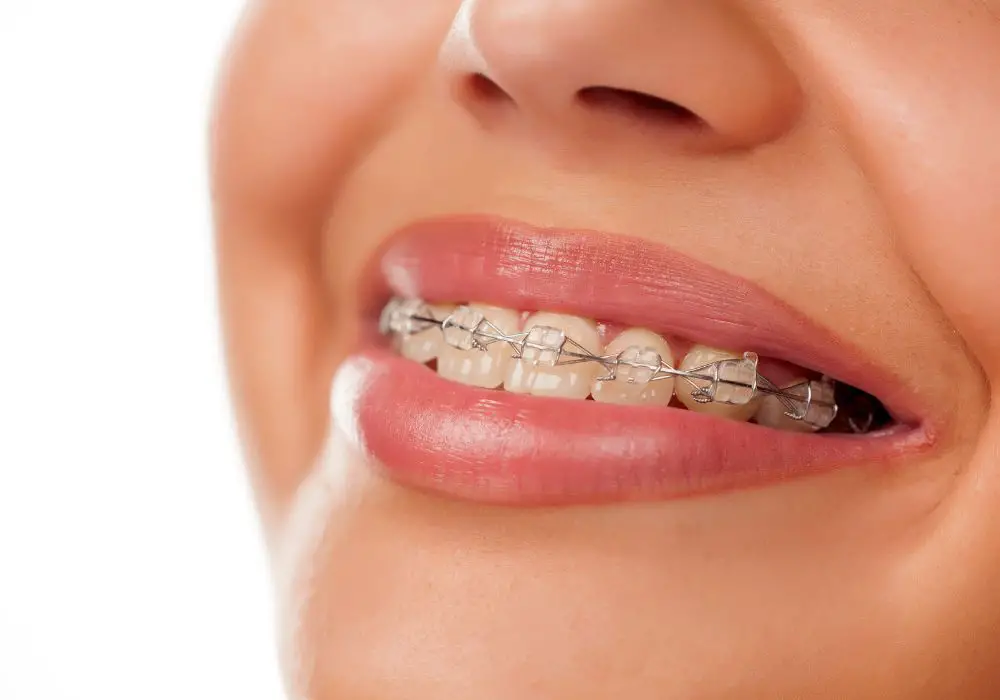
There are several reasons why tooth discoloration is common when wearing braces:
Plaque buildup
Braces make it harder to fully remove plaque from teeth when brushing and flossing. Plaque is a sticky film of bacteria that adheres to teeth. If not properly cleaned off, plaque hardens into tartar that sticks to teeth. Tartar causes teeth discoloration.
The brackets, wires, and other components of braces provide additional surfaces for plaque to stick to. Food can also easily get trapped by braces, contributing to more plaque buildup. This extra plaque and tartar is harder to fully remove with flossing and brushing when wearing braces.
Enamel demineralization
The brackets and bands placed on teeth during braces treatment can create tiny gaps between the braces and teeth. Bacteria can thrive in these gaps and release acids that break down tooth enamel in a process called demineralization. Demineralization makes the enamel porous and discolored.
Food and drink staining
Braces block some of the tooth surface from thorough cleaning. This allows deeply colored foods and drinks like coffee, red wine, and blueberries to more permanently stain teeth. The brackets hold stains close to the enamel where they can penetrate into porous demineralized spots.
Metal brackets and wires
The metals used in braces like stainless steel or nickel-titanium alloys can rub off color onto teeth surfaces. Friction from these metal parts during braces adjustments can also stain tooth enamel.
Interference with dental hygiene
The braces themselves hinder fully cleaning teeth each day. Flossing and brushing take longer and are less effective. Many brush heads don’t fit properly around braces. Irrigation devices like water flossers might be needed for the best cleaning. Poor cleaning allows more plaque buildup and eating/drinking stains.
Are certain types of braces more likely to cause tooth discoloration?
Yes, some types of braces and bracket materials are more prone to causing tooth discoloration:
- Traditional metal braces – The metal brackets and wires cause more staining from friction. Plaque also sticks more to the metal.
- Self-ligating braces – These still use metal brackets and wires that can rub off and harbor plaque. However, the brackets have slide covers instead of elastic ties to reduce staining.
- Lingual braces – These braces are affixed to the tongue-facing side of teeth. They are harder to keep clean and cause more plaque buildup.
- Ceramic/plastic braces – Ceramic or plastic brackets resist permanent staining better than metal. Clear aligners like Invisalign are even less likely to stain teeth.
At what point during treatment do teeth start to stain?
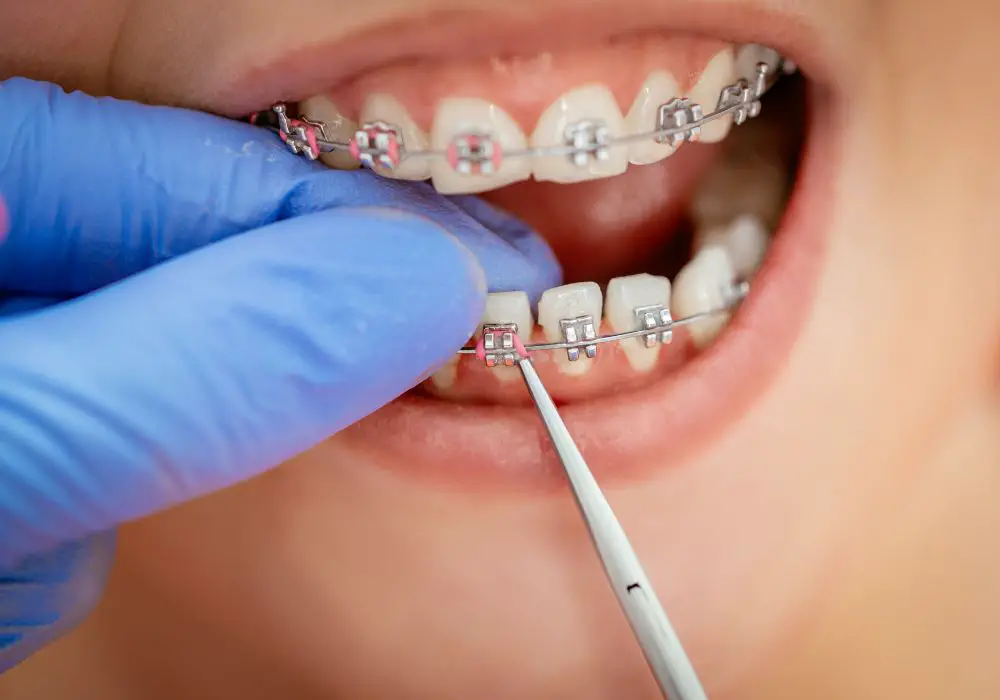
Most patients notice teeth yellowing or staining about 3-6 months into braces treatment.
However, teeth can start accumulating more plaque in just days to weeks after getting braces on. It takes time for enough tartar and stains to build up to visibly alter tooth color. Teenagers also commonly get braces as permanent teeth are still mineralizing and maturing, so their enamel is more prone to demineralization damage in the first year.
Staining then worsens throughout treatment as brackets remain on teeth for 2-3 years on average. Proper hygiene and regular teeth cleanings can minimize discoloration.
Can teeth staining be prevented with braces?
It’s impossible to fully prevent some tooth discoloration when wearing braces long-term. However, good oral hygiene and diet can help minimize staining. Recommendations include:
- Brush after every meal with an orthodontic brush
- Use interdental brushes and irrigators to clean braces
- Floss carefully under wires
- Get professional cleanings every 3-4 months
- Avoid staining foods/drinks like coffee, wine, tea etc.
- Use straws when drinking staining beverages
- Rinse with water after eating/drinking
- Apply dental wax over brackets to reduce friction
- Get white spot lesions treated quickly before they stain further
Using clear ceramic braces, Invisalign, or gold brackets can also help prevent discoloration from metal parts. However, keeping teeth clean is most important.
What are the best ways to remove stains on teeth during braces treatment?
While on-going stain prevention is ideal, teeth whitening can also improve the appearance of discolored teeth during braces:
- In-office whitening – A dentist applies a high-concentration peroxide gel and uses a special curing light to whiten teeth. This is the fastest and most dramatic way to brighten teeth with braces.
- Take-home whitening trays – Custom trays are filled with lower concentration whiting gel to wear at home for a few hours at a time. Takes 1-2 weeks to see results.
- Whitening toothpastes – Special abrasive toothpastes help scrub away some exterior stains on teeth. Results are milder and take longer.
- Over-the-counter whitening strips – Apply strips or paint-on gels to front teeth. Can’t fully whiten teeth with braces on. May just lighten spots between brackets.
Any whitening treatments should be done carefully under a dentist’s supervision to avoid irritation of gums and enamel. Proper isolation and lower peroxide levels are safer for braces.
Can I get my teeth whitened right after braces?
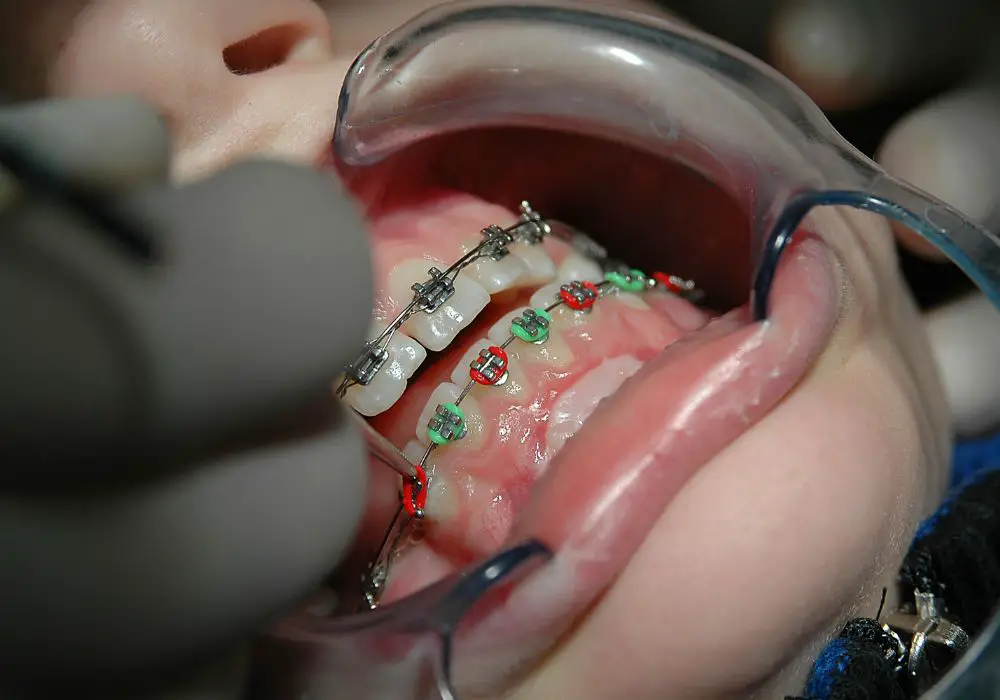
Yes, it’s recommended to get teeth professionally whitened soon after braces removal. New stains haven’t fully set into enamel after braces therapy. Teeth are also most porous and susceptible to whitening agents after being in braces.
Over-the-counter whitening and trays are usually inadequate to fully brighten teeth after prolonged braces stains. An in-office treatment by your dentist within 2 weeks of debonding braces is most effective.
However, teeth and gums may be irritated and sensitive just after braces removal. Taking a week break allows them to heal before intensive whitening sessions.
What are the risks of tooth discoloration after braces treatment?
If tooth stains from braces are not treated, they can worsen and become permanent. Yellow or brown spots in enamel that aren’t promptly whitened after braces removal can no longer be fixed.
The longer stains sit in enamel, the deeper they penetrate. Post-braces, teeth are also most vulnerable to picking up new stains as they are drier and pores haven’t filled back in.
Beyond just appearance concerns, discolored teeth after braces can also lead to issues like:
- Tooth decay in demineralized white spots
- Gum disease from plaque buildup in stains
- Jawbone loss from inflammation spreading under teeth
- Food buildup in deep staining grooves
That’s why it’s critical to keep teeth clean during braces and get any stains properly treated before they risk enamel and oral health.
Frequently Asked Questions
Should I avoid foods and drinks that stain teeth during braces?
It’s smart to cut down on staining foods, but you don’t need to avoid them completely. Using a straw, rinsing promptly after, and brushing can minimize risks. Whitening periodically can also remove any stains.
Do clear aligners like Invisalign still cause teeth staining?
Invisalign causes less staining due to no metal brackets. However, aligner trays can still trap sugars against teeth leading to plaque buildup. Maintaining excellent hygiene is still essential.
Can teeth be whitened during braces treatment?
Yes, but in-office methods with lower hydrogen peroxide are safer to not disturb braces. Always see your dentist to whiten during braces. Overdoing it can damage tender gums and enamel.
Should I whiten my teeth before getting braces put on?
It’s not necessary, but can maximize your bright smile after braces. Stains may still develop during treatment though. Talk to your orthodontist about options to touch up whitening right before brace removal.
How white will my teeth get after professional whitening?
Everyone’s teeth whiten differently based on genetics, age, and stain level. On average, in-office whitening makes teeth 2-8 shades brighter. Teeth won’t be as white as celebrity smiles you see in magazines. Manage your expectations.
Conclusion
While tooth discoloration from braces can be discouraging, being diligent with hygiene and whitening can keep your smile bright. Preventing stains before they set in helps safeguard the health of your teeth for the long-term after braces. With proper care, you can complete orthodontic treatment with an improved, beautiful smile.

